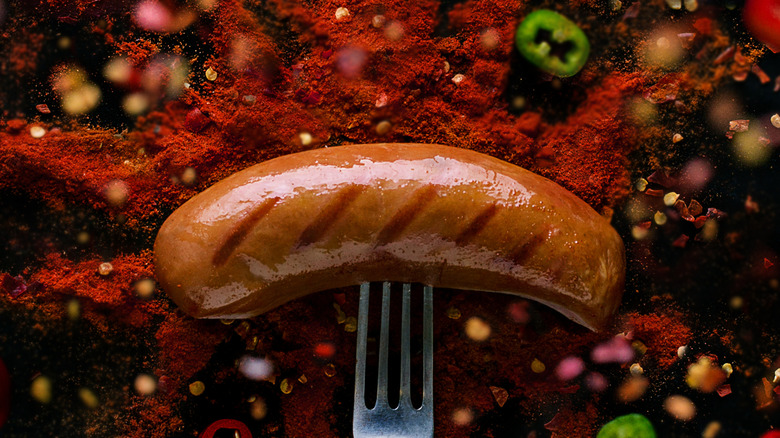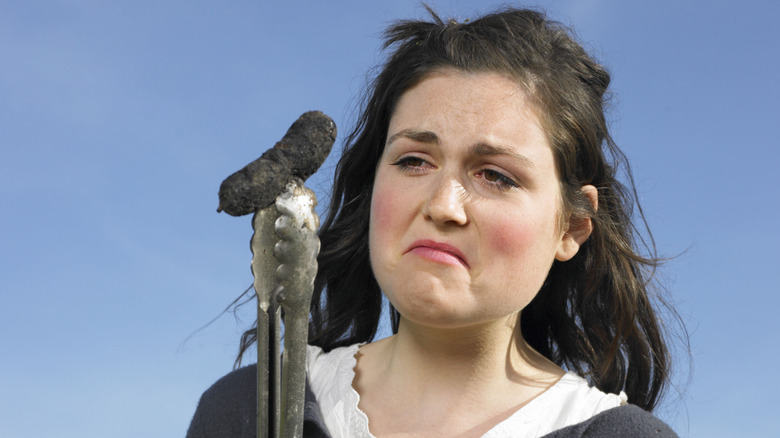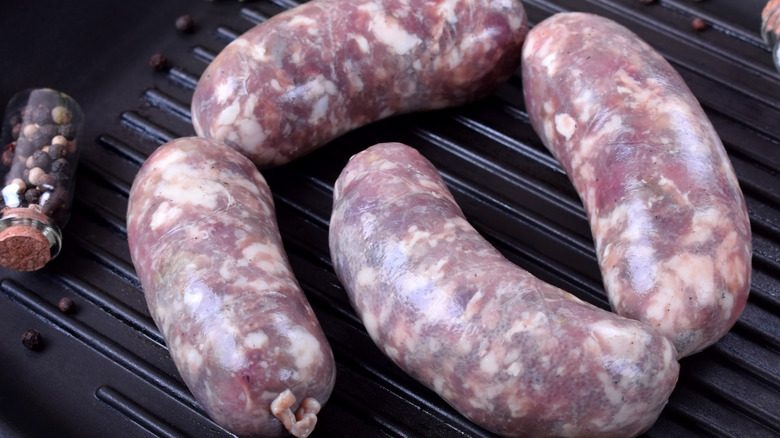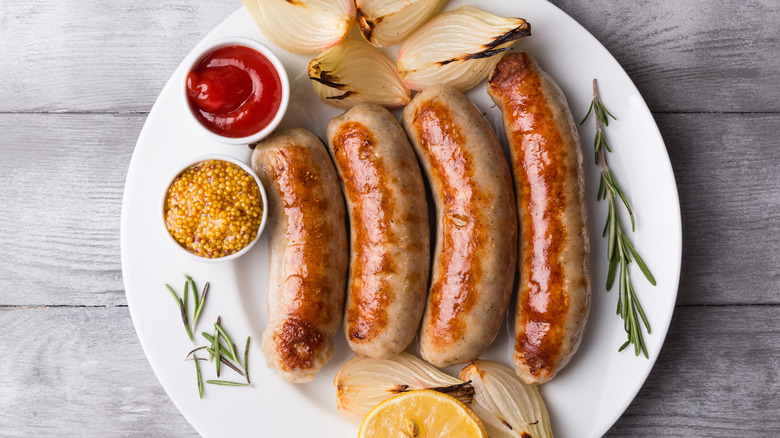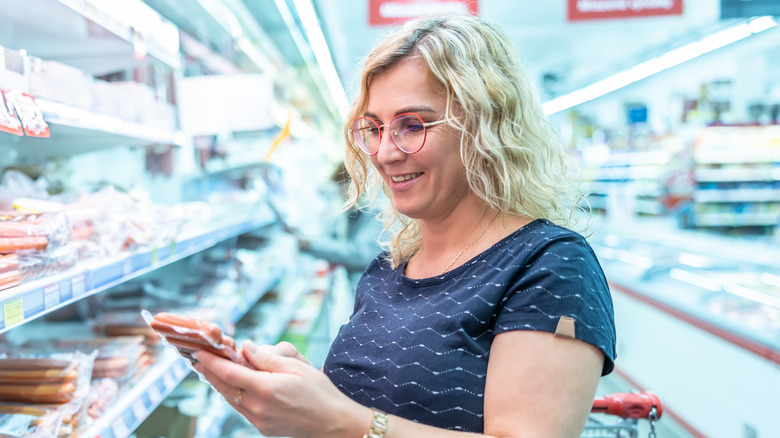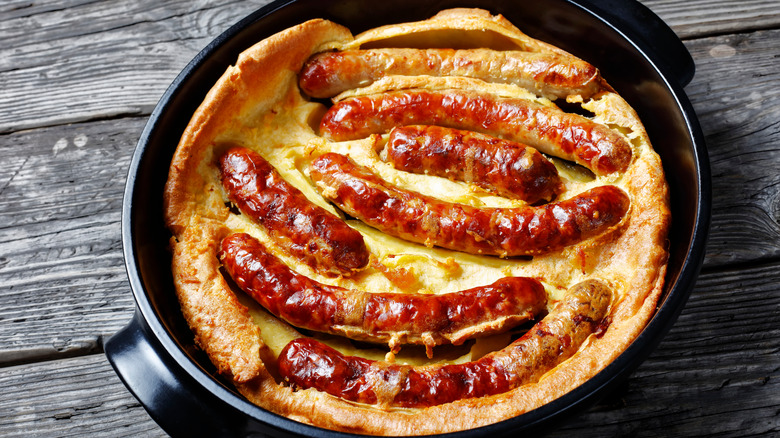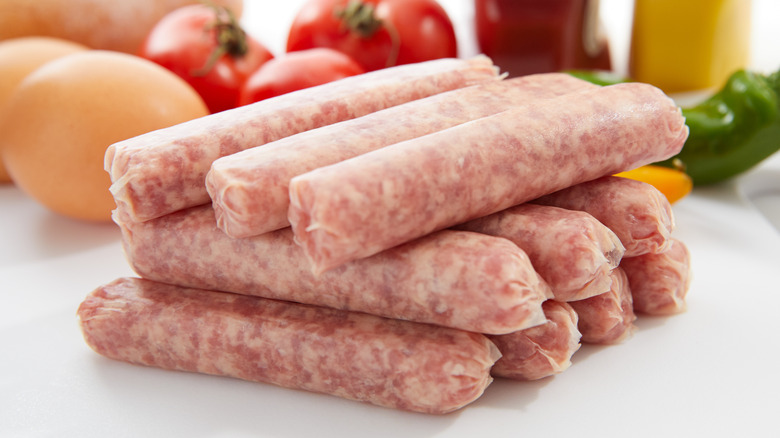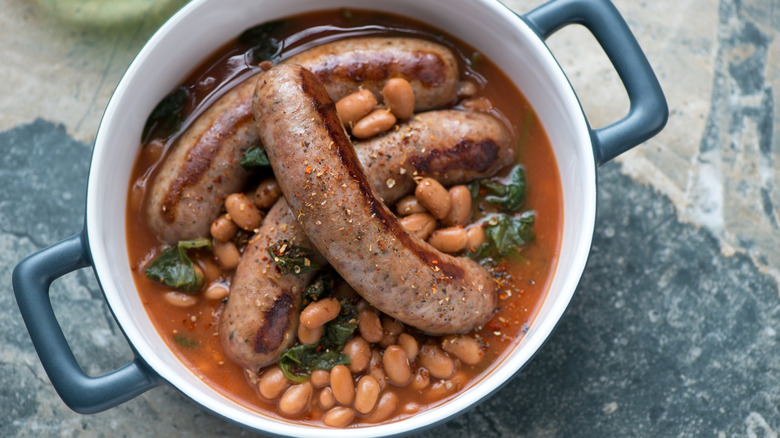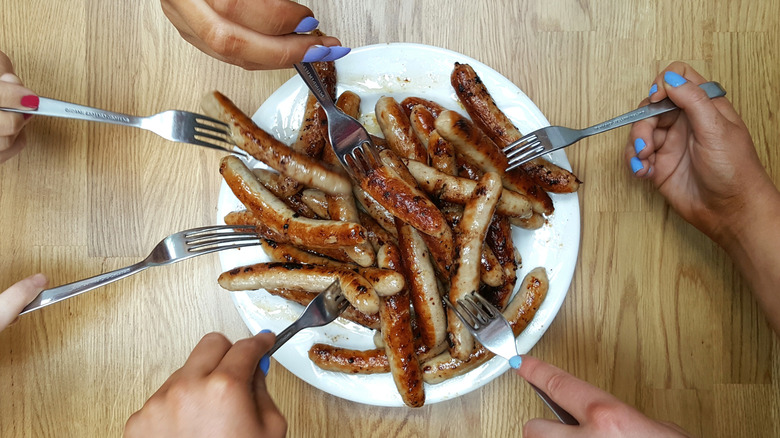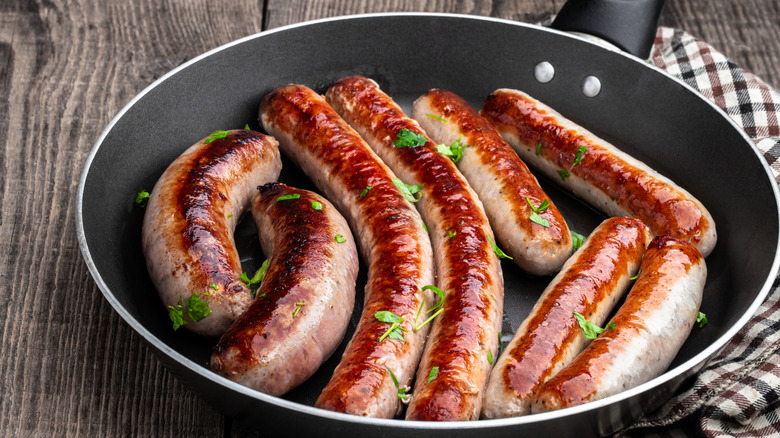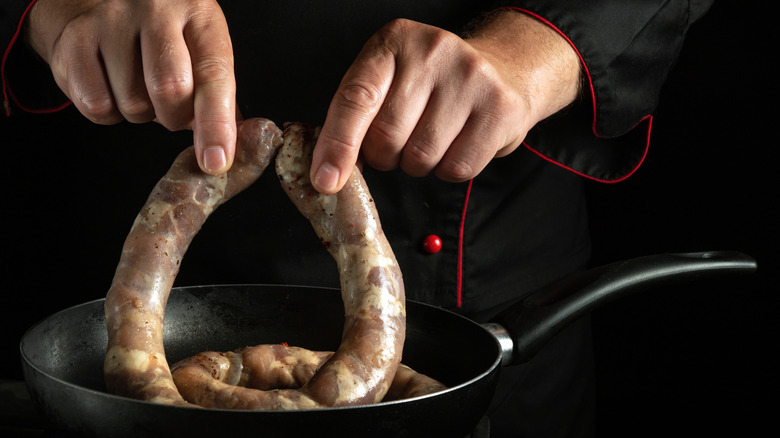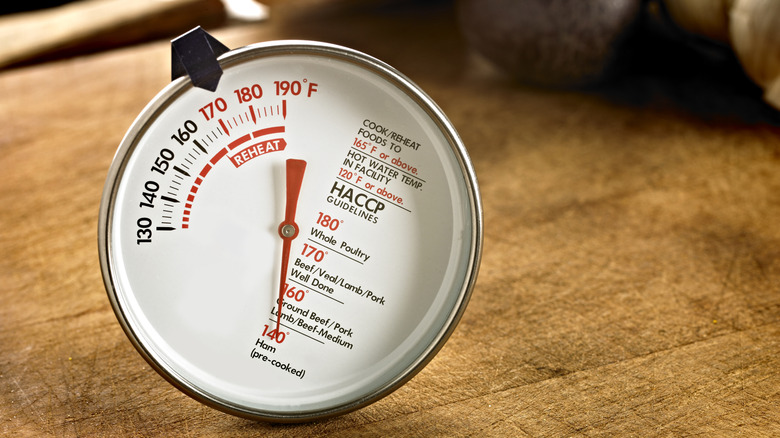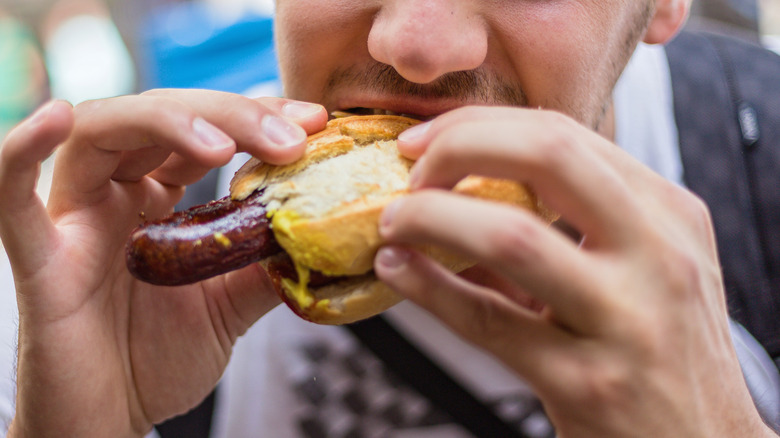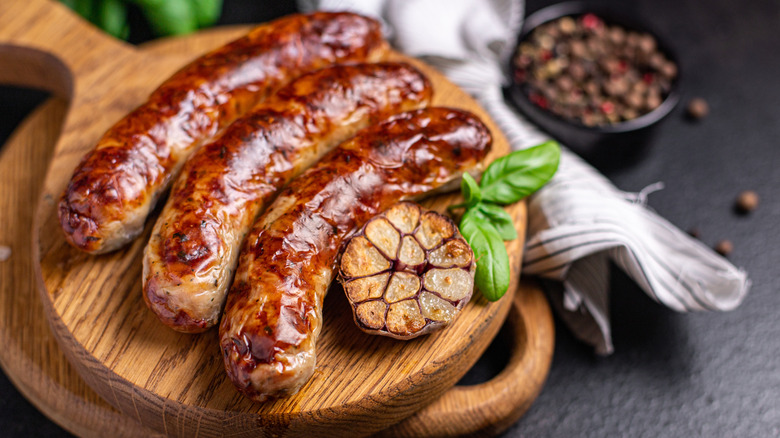The Best Tips For Cooking Sausage, According To Industry Experts
We may receive a commission on purchases made from links.
Who doesn't love plunging their teeth into a sizzling, tasty sausage? It's the perfect meat protein boost, whether for breakfast, lunch, or dinner. Sausages come in a range of sizes, shapes and flavors — and they can keep for months in the freezer. Even vegetarians and vegans can get behind them, thanks to the wide range of plant-based versions. No wonder we love them so much.
You would think that vast appetite would mean everyone knows how to get the absolute best from their sausages. After all, they're easy to cook, right? Just throw 'em in a pan and leave them to do their thing. Well, not so fast.
It turns out this staple food comes with a little more culinary baggage than meets the eye. From why it's a bad idea to overcrowd the pan and how to make sure your next cookout sausages won't make everyone sick, to the endless debate about whether to prick them or not, experts Heidi Cooper, general manager of Lilac Hedge Farm, Olly Kohn, co-owner of British company The Jolly Hog, and Diana Stavaridis, culinary director at Beyond Meat tell us their best tips for cooking sausages.
The biggest mistakes when home cooking sausages
Sausages can be cooked in lots of ways. They're delicious prepared in a pan on the stove, on a barbecue, in an air fryer, or a traditional oven. Despite that flexibility, many people make mistakes that mean the sausages on their plates are more of a whimper.
Heidi Cooper said her favorite is their chipotle pork sausage with uncured bacon and pepper jack cheese. And when it comes to getting the best out of all sausages, there are two things she believes most home cooks get wrong: overcooking them and not letting their sausages rest.
"One of the worst things you can do that destroys a food cut of meat, no matter what it is, is to overcook it," Cooper said. "Pay close attention to them as they cook and use a meat thermometer to catch them at an ideal temperature before you remove them from the heat to rest and finish their last few degrees of cooking."
How you cook your sausage impacts the flavor
When it comes to flavor, we are spoiled for choice with sausages, but how we choose to cook them has a direct impact on how the finished results taste. Heidi Cooper recommended cooking sausages that are made with fresh, quality ingredients, and said: "As with most all meats, locking in flavor with a sear on the outside can make a world of difference... Having a nice crisp caramelization on the casing can make all the difference on the overall richness."
Olly Kohn is a sucker for his firm's pork black pudding and dried apple sausage. He warned that sweeter varieties will cook differently because of their higher sugar content. "Some sausages have apple or caramelized onion or honey in them, those ones will cook and caramelize and brown off quicker than something that hasn't got that in."
The same goes for plant-based versions. Diana Stavaridis said the intensity of flavor of the brands Beyond Sausage and Beyond Sun Sausage changed according to how they were prepared. "Cooking on a pan, griddle, or grill will give you more flavor intensity versus cooking the products in a sauce or soup," she explained.
To prick your sausages or not to prick
The argument over whether we should prick sausages before cooking them has probably been around ever since the earliest sausages were formed more than 5,000 years ago. Some people insist that making tiny holes prevents their sausages from splitting or even exploding while cooking. Our experts unanimously disagree.
As far as Diana Stavaridis is concerned, pricking the plant-based sausage is not necessary. The same goes for Olly Kohn. "Probably my top tip is never prick a sausage. Some people prick sausages because they think that's the best way to cook them evenly. Well, actually, by pricking them, all you're doing is letting the flavor and the juices run out, and you want to keep that in the sausage," he said.
Heidi Cooper was also firmly in the 'don't prick' camp. "We want folks to cook safely, but pricking the casing allows all the fat and moisture to be released, resulting in a potentially dry end result," she said, adding, "Using a meat thermometer will naturally pierce the skin, when the time comes, will release some juices or fat, but that should be much after the primary cooking time."
Check the meat content before buying your sausages
As with all food products, there are varying degrees of quality available to buy and sausages are no exception. It's a bit of a myth that they can contain all sorts of gross ingredients: The USDA has strict rules about what can go into different types of sausages, including how much fat they can contain.
For Olly Kohn, checking the meat content of sausages will help home cooks get the best ones on their plates. Premium products should contain between 75% to 80% meat, but sausages that have a percentage of 99%, with no rusk or breadcrumbs are likely to be too dry. "For me, the perfect sort of balance [is] between succulence, flavor and a snap on the bite, plus a meat content where you know that this is actual pieces of meat."
He said the quality of a sausage depends on that content. A rough-textured sausage might not look appealing but it can be proof that, even if they are cheaper, good cuts of meat are being used to make it. "[It] means that leg, shoulder, belly is going into that sausage rather than all of the bits that potentially aren't prime cuts emulsified," he said.
Browning your sausage is always better
Sausages aren't just awesome as a standalone food, they're also amazing as an ingredient in other recipes. In France, it's a key part of cassoulet, while in the U.K., they cover them with Yorkshire pudding batter to create what's affectionately known as 'toad in the hole.' For both dishes, the question of whether to brown the sausage before baking is almost as important as the pricking debate.
For Heidi Cooper, browning locks in flavor and adds excellent exterior texture and depth. "We know folks that swear by both starting with browning or finishing with it. It isn't required but it does take a sausage to the next level when it's cooked properly," she said. Even plant-based sausages benefit from a quick flash in the pan, as Diana Stavaridis explained: "Beyond Sausage and Beyond Sun Sausages do not need to be browned before baking but it is best to brown them before baking to achieve optimal color and texture."
Olly Kohn was even more definitive: "I think if you ask nine out of 10 people, they're like: 'Actually, I like that more well-done sausage.' It's a bit like crispy bacon. Most people want crispy bacon rather than sort of white wobbly bits. Most people like a sort of a caramelized outer edge, especially on a natural casing. With the natural casings, if they're not cooked through, they can be a bit chewier, a bit tougher. So the answer is yes, brown them all off."
Cleaning/patting dry your sausages (or not)
Whether they buy sausages from a store or a butcher, some people insist on patting dry or even cleaning them as part of their cooking preparation. According to the USDA, washing raw meats including poultry, veal, or pork is not a good idea, as "some bacteria can be splashed on the surfaces of your kitchen, which can make you sick if not properly cleaned and sanitized."
For Olly Kohn, patting dry or cleaning sausages is not an issue, either. "If it's bought from a retailer or a butcher, then you should be fine just to chuck it in the tray or the frying pan or on the barbecue... If you're worried about cleaning the outside of a sausage, then you probably should be more worried about the inside as well."
While Diana Stavaridis agreed with Kohn and said Beyond Meat's plant-based sausages didn't need this step, Heidi Cooper was firmly in favor. "Cooking any meat with a pat-dry exterior helps to brown the skin instead of steaming, just like any other cut. This is more common for a great steak to achieve the perfect crust but it is great practice for all cuts you'd like that type of exterior on," she said. It's really up to your personal preference, in the end.
Poaching your sausages is great, but don't forget to brown them
The sound of sausages sizzling in a hot pan has been music to foodies' ears for centuries, but it's not the only way to deliver delicious results. Sausages are also wonderful when poached, either in wine, in a vegetable stock or even a soup. However, all three of our experts said browning the sausages before or after cooking would maximize those flavors.
Heido Cooper said, "Poaching is a great method for improving the overall quality of sausages. It allows the sausage to retain moisture without adding extra cooking oils. After poaching, we recommend finishing the cooking on a grill or skillet to add that extra flavor and texture." Plant-based sausages fare best on the grill or griddle, according to Diana Stavaridis, but they can be cooked in liquid, too.
Flavor retention was a concern for Olly Kohn. "When you're cooking a cassoulet or a stew, browning it off before you put it into the stew mix again means that the skins are more cooked through," he said.
To rest, or not to rest?
Anyone who has ever hosted a Thanksgiving dinner or cooked a Sunday roast has probably allowed the meat at the center of their meal some time to rest. That means it has been taken out of the oven but has been set aside — possibly covered with aluminum foil — for several minutes before it is carved. This period allows the protein fibers within the meat to relax and take back some of the juices released during cooking.
The question of whether sausages need this extra step is another bone of contention. Olly Kohn said sausages were good to go after having been cooked. "It's not like a steak, where you want it to rest for the juices. I think sausages are fine," he said.
Only Heidi Cooper suggested that home cooks allow their sausages rest after they had been cooked. She said: "All meat should rest to allow juices to redistribute, the temperature to stabilize, and the fat to cool so it doesn't squirt when bitten or cut." Once again, it's up to your judgment whether you think your sausage should rest or not.
Don't overcrowd sausages in the pan
One of the best things about sausages is that fresh varieties cook quickly and can be ready to eat in just a few minutes. It's among several reasons they're such a popular staple among home cooks. A mistake many of us make is cramming lots of them in the air fryer section, or a frying pan or a tray. For Olly Kohn, it does a disservice to even the humblest sausage.
"Say you've got a pack of six in a pan and they fit well, then you can move them around a bit and they're going to cook more evenly. That's what you want, an even cook across all of them, rather than it being packed and then not being able to turn them," he said. In fact, the co-author of The Pigs in Blankets Cookbook prefers oven cooking sausages over using a pan.
It's all to do with the sausage casing, as Kohn explained: "A natural casing is a pig's intestine, and that's what artisan sausages and premium sausages are made in, which has got a curve... If you've got a cheaper sausage with a lower meat content and an alginate skin, then it just does cook slightly differently. You can still cook them in the oven, but they don't snap on the skin the same."
Cooking from cold is a-okay
Endless recipes call for the oven to be preheated before we put anything inside. When it comes to cooking sausages on the stove top, some home cooks throw them in after the pan is good and hot, while others don't bother. While Diana Stavaridis agreed both Beyond Sausage and Beyond Sun Sausage could be cooked from cold, she did recommend using a preheated pan for the best results.
For Heidi Cooper, it's all about thorough cooking: "When you start with a cold pan and heat up your sausage gradually, it helps to render the fat instead of heating it so fast that it burns the outside before the inside is done." She reminded home cooks that sausages are a ground meat item and must reach a temperature of 165 F internally. "Just make sure to get that nice golden exterior for optimum flavor," she added.
Anyone who has ever put a cold sausage straight into a hot pan will know it can hiss and spit quite violently. That's why Olly Kohn has no beef with cooking from cold. "You can put a cold sausage into a cold pan and crank up the temperature, there is no issue with that. Warming them gently isn't an issue either. They'll just take longer to cook," he said.
Use a thermometer to check your sausages
Investing in a meat thermometer is essential when cooking sausages. Olly Kohn said there are lots on the market for people to choose from, and added: "As long as you're getting the thermometer into the middle of the sausage, then that's probably the best way." He also recommended using a barbecue as a way to hot smoke sausages, cooking them evenly and thoroughly: "You get an amazing snap on the sausage. It cooks them nice and slowly, and it just adds a real depth of flavor."
Heidi Cooper is also a fan of meat thermometers, calling them a "trusted tool for food safety." She said: "When you begin with poaching in a roughly 170 F salted water pot, home cooks can make sure they achieve a safe degree of interior temperature for transferring to the grill."
Overcoming tragedy: How to rescue a burned sausage
Whether you throw them into a sizzling, hot pan or carefully place them into a cold one, anyone who has ever cooked a sausage has probably burned one or two in their time. Sure, some people relish those crispy, blackened bits that stick to the pan or cling to the barbecue grill.
But just in case that's not you, don't despair. According to Olly Kohn, it is possible to enjoy a sausage that's a bit or even a lot overdone. "There's no sauce that's going to rescue a burnt sausage," he said. "But you can always chuck it in a brioche bun with French's mustard, American mustard, tomato ketchup and some onions, and you're going to disguise that burnt flavor."
All about plant-based sausages
Plant-based eating is a growing worldwide trend as more people look for healthier, more sustainable versions of their favorite foods — including sausages. While you don't have to be vegetarian or vegan to try them, for home cooks or parents looking to reduce their family's meat protein intake, they are a viable and tasty alternative.
Diana Stavaridis said the latest products from Beyond Meat were the fourth iteration of sausages made from plant-based proteins. Both coconut and canola oils in Beyond Sausage and Beyond Sun Sausage have been swapped out for heart-healthy avocado oil, and the benefits didn't end there. "We reduced the saturated fat by 66% versus the previous version of Beyond Sausage — just 2 grams per link, which is 75% less saturated fat than traditional pork sausage," she said. You can still use all these tips we discussed for cooking sausage on your plant-based sausages, too.
